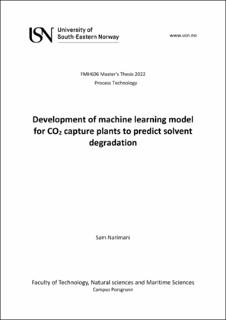| dc.description.abstract | Increasing average temperature of the earth has significantly influenced human’s life that many efforts have been carried out to cut the major sources of rising temperature. Among all, emissions and specifically carbon plays a key role as a type of greenhouse gasses in this area. Therefore, capturing CO2 has become an area of interest for researchers to deal with in the recent years. Carbon capture can be performed by employing several methods, but the most common method is post-combustion since it can be installed for the plants constructed before and there is no need to change any structure in the previous plant. However, there are many problems in the post-combustion carbon plant, such as solvent degradation, which is the most important phenomena as its cost is counted for about 20% of the total operational cost of a carbon capture plant. Therefore, finding the causes can significantly affect the performance of a carbon capture plant. In this study, the focus is on behavior of carbon capture plant in the subject of solvent degradation by using machine learning methods. As this phenomenon has a complex behavior and there are no certain traditional methods or software to simulate the solvent degradation of a carbon capture plant, machine learning would be an efficient method to predict this phenomenon. Although there are many methods in machine learning, several methods such as Artificial Neural Network, Random Forest and Support Vector Regression have been so popular in the literature review. Therefore, these methods are employed to model the solvent degradation in the carbon capture plant. First, lab and online data provided by Technology Centre Mongstad, were cleaned. Secondly, to enhance the performance of the model, feature selection methods like Spearman’s and Pearson’s correlation methods were applied to decrease the number of features. There are many sources of solvent degradation in a carbon capture plant, but in the current one information about ten sources of solvent degradation is available. Therefore, ten various models with different hyperparameters and features were utilized to reach the best results. Results show that ANN and Random Forest are the best and most promising models to predict the solvent degradation behavior in the plant as compared to the R2 score that was mainly more than 0.90 for 483 datasets received from TCM. | |
